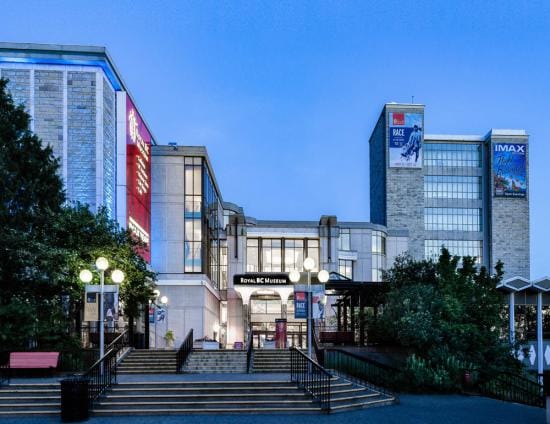
Modernization
Learn more about government’s intention to modernize the museum to protect our historic holdings and provide better access to our collections.
Victoria, BC— For the first time, footprints of armoured dinosaurs with tail clubs have been identified, following discoveries made in the Canadian Rockies. The 100-million-year-old fossilized footprints were found at sites at both Tumbler Ridge, BC, and northwestern Alberta.
There are two main groups of ankylosaurs. Nodosaurid ankylosaurs have a flexible tail and four toes, while ankylosaurid ankylosaurs have a sledgehammer-like tail club, and only three toes on their feet.
Unlike the well-known ankylosaur footprints called Tetrapodosaurus borealis found across North America, which have four toes, these new tracks have only three—making them the first known examples of ankylosaurid ankylosaur footprints anywhere in the world. The expert team named the new species of this ankylosaurid ankylosaur Ruopodosaurus clava. It means 'the tumbled-down lizard with a club/mace,' referencing both the mountainous location in which these tracks were discovered and the distinctive tail clubs of these dinosaurs.
A research team including Dr. Victoria Arbour, the curator of palaeontology at the Royal BC Museum, alongside researchers from the Tumbler Ridge Museum and the Tumbler Ridge UNESCO Global Geopark, report their findings in the peer-reviewed Journal of Vertebrate Paleontology.
“While we don’t know exactly what the dinosaur that made Ruopodosaurus footprints looked like, we know that it would have been about 5-6 metres long, spiky and armoured, and with a stiff tail or a full tail club,” says Arbour, an evolutionary biologist and vertebrate palaeontologist who specializes in the study on ankylosaurs. “Ankylosaurs are my favourite group of dinosaurs to work on, so being able to identify new examples of these dinosaurs in British Columbia is really exciting for me.”
Dr. Charles Helm, scientific advisor at the Tumbler Ridge Museum, had noted the presence of several of these three-toed ankylosaur trackways around Tumbler Ridge for several years, and invited Arbour to work together to identify and interpret them during a visit in 2023. Eamon Drysdale, curator at the Tumbler Ridge Museum, Roy Rule, geoscientist at the Tumbler Ridge UNESCO Global Geopark, and the late Martin Lockley, formerly of the University of Colorado, contributed to the study.
The tracks date back to the middle of the Cretaceous period, about 100 to 94 million years ago. No bones from ankylosaurids have been found in North America from about 100 to 84 million years ago, leading to some speculation that ankylosaurids had disappeared from North America during this time. These footprints show that tail-clubbed ankylosaurs were alive and well in North America during this gap in the skeletal fossil record. The discovery also shows that the two main types of ankylosaurs—nodosaurids and ankylosaurids, including this new three-toed species—coexisted in the same region during this time.
“Ever since two young boys discovered an ankylosaur trackway close to Tumbler Ridge in the year 2000, ankylosaurs and Tumbler Ridge have been synonymous. It is really exciting to now know through this research that there are two types of ankylosaurs that called this region home, and that Ruopodosaurus has only been identified in this part of Canada,” says Helm.
“This study also highlights how important the Peace Region of northeastern BC is for understanding the evolution of dinosaurs in North America – there’s still lots more to be discovered,” says Arbour.
This find gives us a new piece of the puzzle about the ancient creatures that once roamed what is now Canada.
Visit the Royal BC Museum Flickr page for images: https://flic.kr/s/aHBqjC7xMr.
— 30 —
About the Royal BC Museum: The Royal BC Museum, which includes BC Archives, IMAX® Victoria and PARC Campus, is one of the oldest continually operating museums in Canada. A centre of learning and research, it strives to broaden our understanding of British Columbia through collections, exhibitions, outreach and community engagement. The museum celebrates the province’s diverse landscapes and the lives of the people who live here, enables research and knowledge sharing that advances our understanding of our world, and provides a dynamic place for discussion and reflection. IMAX® Victoria delivers educational and entertaining experiences that accompany the learning journey the museum offers.
The Royal BC Museum is located on the traditional lands of the lək̓ʷəŋən peoples, known today as the Songhees and Xʷsepsəm (Esquimalt) Nations. We acknowledge and respect the history of Indigenous peoples, who are our partners in museum matters and community alike.
About the Tumbler Ridge Museum: The Tumbler Ridge Museum Foundation is dedicated to the conservation, preservation, research and display of British Columbia’s fossil heritage and Tumbler Ridge history through science, historical archives and public education. We undertake these activities while maintaining the highest possible professional and ethical standards. Together with our community, we dig deeper into our story and engage in discovery.
The Tumbler Ridge Museum is located in the Tumbler Ridge UNESCO Global Geopark in the Treaty 8 Territory in Northeast British Columbia, on the lands of the Dunne-Za, Ts’Khene, Saulteau, Cree and Métis Peoples.